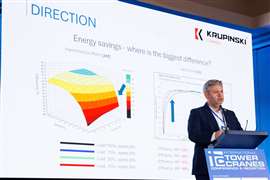What is the status of the North American RT market?
21 August 2023
With infrastructure and industrial construction on the rise, rough terrain cranes that may have been sitting unused are now plugging away on jobs across the U.S., Canada and Mexico. A crucial asset in any crane fleet, the RT is versatile, reliable and a market mainstay. While mid-size models are proving to be most popular among rental companies and end-users, as projects and materials continue to push the envelope, so does the demand for higher capacity RTs.
While compiling information on the latest and greatest rough terrain models, American Cranes & Transport asked RT manufacturers to choose one model to highlight in this article. Shown are the models they chose to feature, along with their specs.
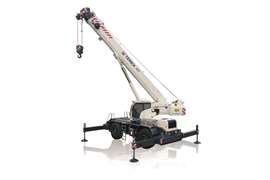 Terex TRT 70US Capacity of Crane: 70 tons Main Boom Length: 143 feet Fixed Jib Length: 1.3 feet Luffing Jib: 26/49 feet Maximum Line Speed: 338 feet/min Boom Length with Jibs: 151 feet Total Tip Height: 200 feet with jib Counterweight: 13,230 pounds
Terex TRT 70US Capacity of Crane: 70 tons Main Boom Length: 143 feet Fixed Jib Length: 1.3 feet Luffing Jib: 26/49 feet Maximum Line Speed: 338 feet/min Boom Length with Jibs: 151 feet Total Tip Height: 200 feet with jib Counterweight: 13,230 pounds
Trending upwards
Terex Cranes is seeing a very active market for rough terrain cranes, with notable popularity in the 70 to 100-ton class. However, Terex’s Andreas Ernst, general manger cranes Americas, said the company is also seeing a positive trend in the smaller capacity range.
The Terex rough terrain product line offers a lifting capacity range from 40 to 100 tons, up to 154 feet of maximum boom length with three boom modes, up to 162.4-foot tip height with main boom and up to 217-foot tip height with jib.
“They also feature the new TEOS operating system with a 10-inch full-color touch screen display,” Ernst added. “Terex RT cranes come equipped with T-Link telematics, wide tiltable cabins, heating and air conditioning, superior load charts and tip heights, four steering modes, with additional options including: up to four cameras, remote radio control, auxiliary winch and additional jibs.”
The latest model is the TRT 70US, which meets market and customer demands for a flexible, durable off-road crane. The versatile crane caters to several applications, including ports, construction, infrastructure, mining, energy, yard logistics and general lifting.
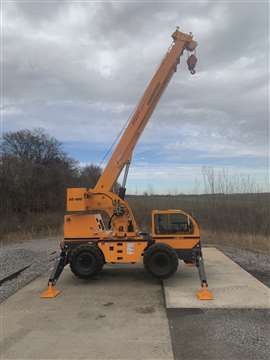 Broderson RT-400-B Capacity of Crane: 20 tons Main Boom Length: 69 feet 6 inches Fixed Jib Length: N/A Luffing Jib: N/A Maximum Line Speed: 209 feet/min Boom Length with Jibs: N/A Total Tip Height: 80 feet Counterweight: 8,250 pounds
Broderson RT-400-B Capacity of Crane: 20 tons Main Boom Length: 69 feet 6 inches Fixed Jib Length: N/A Luffing Jib: N/A Maximum Line Speed: 209 feet/min Boom Length with Jibs: N/A Total Tip Height: 80 feet Counterweight: 8,250 pounds
High expectations
Broderson rough terrain cranes are often used for maintenance work where machine dependability and productivity are necessary to maintain schedules.
“We maintain a focus on dependability, productivity and safety of our equipment to meet our customer’s expectations of our cranes,” said Ed Hisrich, Broderson’s vice president of sales.
While Broderson only has one rough terrain model, the 20-ton capacity RT-400, demand for the model has been consistent. It is a fixed cab unit with swing down outriggers. Its construction makes it ideal for lifting jobs in worksites that are congested where small dimensions and a high level of maneuverability is required.
“But as a crane manufacturer, the biggest challenges have been supply chain shortages and high inflation,” Hisrich explained. “These challenges have been equally impactful on the consumers as well.”
Strong demand
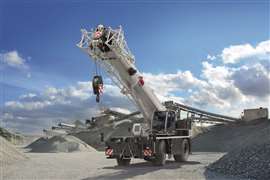 Liebherr LRT 1130 2.1 Capacity of Crane: 140 tons Main Boom Length: 197 feet Jib Length: 35-62 feet with 23-foot insert. Luffing Jib: N/A Maximum Line Speed: N/A Boom Length with Jibs: 282 feet Total Tip Height: 279 feet Counterweight: 45,400 pounds
Liebherr LRT 1130 2.1 Capacity of Crane: 140 tons Main Boom Length: 197 feet Jib Length: 35-62 feet with 23-foot insert. Luffing Jib: N/A Maximum Line Speed: N/A Boom Length with Jibs: 282 feet Total Tip Height: 279 feet Counterweight: 45,400 pounds
Liebherr USA’s Beau Pocock, business development manager and product specialist for rough terrain, all-terrain and telecrawler cranes, cites similar hurdles, including supply chain issues and equipment availability. However, the rough terrain crane market persists.
“The rough terrain market remains strong and demand for larger, more versatile machines continues to grow,” he said.
At Liebherr, although the 100-ton class machines hold a high market demand, the need for the 130 to 140-ton machines is seeing more demand. Pocock believes this trend will continue to grow over time as users need to access heavier loads.
Increased capacity
Overall utilization rates and rental rates have been seeing a positive advancement since the Covid pandemic ended, according to Tadano America. Customers continue to push for increased capacity on job sites as materials and components get larger and heavier. Jobsite safety is also a priority, according to the company.
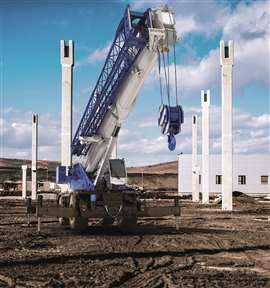 Tadano GR-1000XLL-4 Capacity of Crane: 100 tons Main Boom Length: 42.0 - 167.3 feet Fixed Jib Length: Mechanically off-settable (3.5, 25, 45 deg) 33.2 - 58.1 ft Maximum Line Speed: 491 fps (4th layer) Max Boom & Jib Length: 225.4 feet (167.3 + 58.1 feet) Max Hook Height: 224.1 feet Counterweight: Hydraulically removable, 24,100 pounds
Tadano GR-1000XLL-4 Capacity of Crane: 100 tons Main Boom Length: 42.0 - 167.3 feet Fixed Jib Length: Mechanically off-settable (3.5, 25, 45 deg) 33.2 - 58.1 ft Maximum Line Speed: 491 fps (4th layer) Max Boom & Jib Length: 225.4 feet (167.3 + 58.1 feet) Max Hook Height: 224.1 feet Counterweight: Hydraulically removable, 24,100 pounds
“The RT market is characterized by a strengthening of current infrastructure projects such as road and bridge construction, refinery shutdowns, semiconductor plant construction, wind industry and other projects driving demand for these jobsite workhorses,” said Dan Melnyk, director of sales, North America, for Tadano America.
The current capacity class that has shown a strong demand would fall into the 80 to 100-ton range with an increase in the 130 to 160-ton class, he said. Tadano’s rough terrain product offering spans from 35 to 160 tons rated capacity. All Tadano GRs have asymmetrical outrigger set ups, with many having the SmartChart feature. SmartChart optimizes the lifting capacities over the outriggers to maximize the capability of the crane.
“Our new fourth generation cranes include many new features, such as Clearance Sonar, improved access to the cab, multiple cameras (rear view, winch cameras, EcoMode, tiltable cab, and blind spot camera,” added Lance Rydbom, director product management and engineering for Tadano. “Our 100-ton cranes (GR-1000XL-4 and GR-1000XLL-4) feature SmartCW which allows the operator to utilize two counterweight positions.”
Bridging the gap
As the world recovers from a down market during the Covid years and with the passing of the new infrastructure bill, demand is picking up and finding equipment manufacturers unprepared.
“There is a lack availability of new machines in the marketplace which means auctions are fetching higher prices as customers look towards used machines to fulfill their needs,” said Brian Smoot, product manager for Sany.
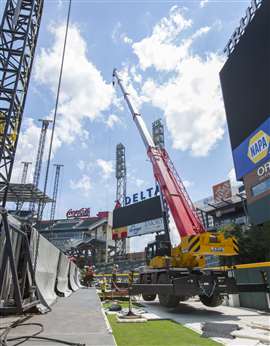 Sany SRA750A Capacity of Crane: 75 tons Main Boom Length: 37.1-142.7 feet Fixed Jib Length: 32.8-55.8 feet Luffing Jib: N/A Maximum Line Speed: 492 ft/min Boom Length with Jibs: 142.7 + 55.8 feet Total Tip Height: 206.6 feet Counterweight:10,100 pounds
Sany SRA750A Capacity of Crane: 75 tons Main Boom Length: 37.1-142.7 feet Fixed Jib Length: 32.8-55.8 feet Luffing Jib: N/A Maximum Line Speed: 492 ft/min Boom Length with Jibs: 142.7 + 55.8 feet Total Tip Height: 206.6 feet Counterweight:10,100 pounds
Sany’s 75-ton and 100-ton classes are seeing the strongest demand for rough terrain cranes, which is why the company purposefully selected the SRA750A and SRA1000A to introduce to the American market first.
“America’s rough terrain cranes are easy to transport with lower overall height and easily accessible tie downs for logistics companies,” said Smoot.
However, the American market isn’t without challenges.
“Availability is still the biggest challenge, closely followed by logistics and shipping costs, which are at historically high rates,” added Smoot. “For manufacturers, the disrupted supply chain has caused delays. For construction companies, uncertainty in the state of the current economy
makes them question whether they should wait to spend. They wonder if they can make their current fleet work, consider renting or consider buying used machines instead.”
Sany America offers four rough terrain crane models ranging from 35 to 120 tons. The company plans to continue to grow its RT line up, with plans to launch another model by early 2024.
Smooth operator
Echoing the sentiment of other RT OEMs, Link-Belt believes that the rough terrain crane market is strong, as the state of the general construction market continues to improve. Cranes that may have been sitting in rental fleets 18 months ago are working, and demand for new cranes is steady. The 80 to 120-ton class remains the most in demand class of RTs for Link-Belt. This has been the case since before the introduction of the 100|RT in 2019.
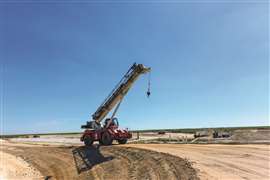 Link-Belt 85|RT Capacity of Crane: 85 tons Main Boom Length: 142 feet Fixed Jib Length: 35 – 58 feet with Link-Belt SmartFly Luffing Jib: N/A Maximum Line Speed: 485 FPM Boom Length with Jibs: 142 + 58 feet Total Tip Height: 208.7 feet Counterweight: 19,200 pounds
Link-Belt 85|RT Capacity of Crane: 85 tons Main Boom Length: 142 feet Fixed Jib Length: 35 – 58 feet with Link-Belt SmartFly Luffing Jib: N/A Maximum Line Speed: 485 FPM Boom Length with Jibs: 142 + 58 feet Total Tip Height: 208.7 feet Counterweight: 19,200 pounds
“Today, our product offering has grown around that class with the 120|RT (120 tons) and most recently the 85|RT (85 tons),” said Kelly Fiechter, product manager for rough terrain cranes at Link-Belt. “We feel the combination of longer booms, capacity at radius and ease of operation all lend themselves to the popularity of our products in and around this most popular class.”
The Link-Belt rough terrain lineup includes seven models, which range from the 65-ton RTC-8065 Series II up to the 160-ton RTC-80160 Series II. In between, the company has introduced a new series of rough terrain cranes aimed at the middle of the RT market with the 75-ton 75|RT, 85-ton 85|RT, 100-ton 100|RT and 120-ton 120|RT. At the heart of this class is Link-Belt’s 85|RT and 100|RT, which offer the features customers have come to expect from Link-Belt: Pulse 2.0, V-CALC, and the Link-Belt SmartFly, Fiechter said.
“Most customers in North America can move our 85|RT in one piece at under 95,000 pounds,” he said. “That’s a great advantage to be able to move a crane with 142 feet of main boom and 58 feet of fly stowed on the side of the boom, unload from a trailer and go straight to work.”
STAY CONNECTED


Receive the information you need when you need it through our world-leading magazines, newsletters and daily briefings.
CONNECT WITH THE TEAM










